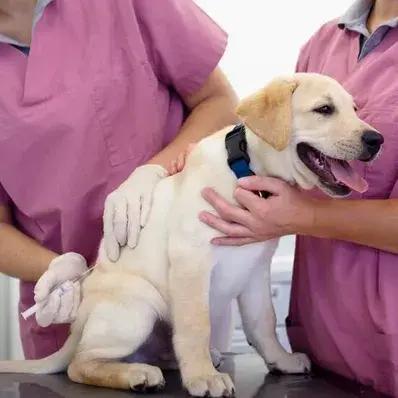Impact of Rabies on Dogs and Humans
Recognizing the impact of rabies on dogs is vital, as it directly relates to the risks and consequences for humans.
- Impact on Dogs
Rabies in dog breeds is caused by the rabies virus, which spreads through saliva via bites or scratches from infected animals.
The rabies symptoms timeline includes:
- Incubation Period: This phase can last weeks to months without visible symptoms.
- Prodromal Stage: Early symptoms like anxiety, fever, and irritability appear.
- Excitative (Furious) Stage: Dogs may exhibit aggression, excessive salivation, and heightened sensitivity.
- Paralytic Stage: Dogs become lethargic, lose motor control, and may experience paralysis, leading to respiratory failure.
Impact on Humans
Humans are at risk of contracting rabies through dog bites, which is why recognizing the symptoms of rabies in dogs to humans is critical. Rabies is a zoonotic disease that can spread from animals to humans and is nearly always fatal if untreated before symptoms arise.
Vaccination and education about the signs and symptoms of rabies in dogs are essential for prevention.
Causes and How Rabies is Transmitted
Understanding rabies transmission and its prevalence emphasizes the need for vaccination and limiting exposure to carriers.
How Common is Rabies in Dogs?
While rabies is rare in vaccinated dogs, it remains a significant issue in areas with poor vaccination coverage. It depends on local prevention efforts, stray animal populations, and wildlife exposure. Unvaccinated dogs that roam outdoors or interact with potentially infected wildlife are at high risk.
Transmission Methods
What causes rabies in dogs is direct contact with the saliva of an infected animal, typically through a bite or open wound. Wild animals like bats, raccoons, and foxes are common carriers of the virus.
Symptoms of Rabies in Dogs
The signs and symptoms progress through distinct stages, each marked by unique behavioral and physical changes.
Early Symptoms (Prodromal Stage)
Subtle behavioral changes like anxiety and irritability often mark the first signs of rabies in dogs. They may become unusually quiet or restless, with noticeable shifts in interactions. Fever, loss of appetite, and sensitivity to light and sound may also develop, signaling the onset of illness.
Advanced Symptoms (Excitative Stage)
In this stage, heightened aggression or extreme fearfulness becomes evident. Dogs may excessively drool or foam at the mouth due to difficulty swallowing. Hyperactivity and unprovoked biting are common, making this phase particularly dangerous as infected dogs are highly contagious.
Final Symptoms (Paralytic Stage)
Dogs experience limb weakness and struggle to stand or move. Swallowing becomes impossible, leading to paralysis that spreads throughout the body. Respiratory failure follows, making early detection and prevention critical as the disease becomes irreversible.
How to Test for Rabies in Dogs
Veterinarians determine rabies based on observed signs of rabies in dogs and the pet’s medical history. Diagnostic tests to confirm the virus often involve lab analysis of brain tissue, which can only be performed post-mortem.
Therefore, the focus is on prevention and recognizing symptoms early. For live animals, veterinarians may rely on quarantine and behavioral observations when deciding how to test for rabies in dogs.
Is Rabies in Dogs Treatable?
Rabies is untreatable once symptoms appear. Prevention through vaccination is the only effective strategy. The vaccine for rabies in dogs is highly effective when administered according to your veterinarian’s schedule.
Preventing Rabies in Dogs
Prioritizing vaccination and taking preventive steps can greatly reduce the risk of rabies in your dog, keeping both your pet and family safe.
Vaccination is Key
- Ensure your dog receives its first rabies vaccine by 3-4 months of age.
- Follow up with booster vaccination as recommended by your veterinarian.
Other Preventative Measures
- Supervise your dog outdoors to avoid contact with wild animals.
- Avoid handling wildlife or stray animals.
- Educate others about the risks of signs of rabies in dogs and the importance of vaccination.
What to Do If Your Dog is Bitten?
If you suspect your dog has been bitten by a potentially rabid animal:
- Clean the Wound: Immediately wash the wound with soap and water for 15 minutes.
- Contact Your Veterinarian: They will assess the situation and determine if post-exposure prophylaxis or quarantine is necessary.
- Monitor for Symptoms: Watch for early signs, as the rabies in dogs incubation period can vary.
Myths About Rabies in Dogs
- Myth: Only stray dogs get rabies.
Fact: Even indoor dogs are at risk if exposed to wildlife or unvaccinated animals.
- Myth: Vaccinated dogs don’t need boosters.
Fact: Booster shots are necessary to maintain immunity.
- Myth: Rabies only spreads through bites.
Fact: Rabies can also spread through saliva entering open wounds or mucous membranes.
Rabies in dogs is a fatal disease, but it is entirely preventable with proper care and timely vaccination. Following a puppy vaccine schedule is crucial to ensure your pet receives protection from rabies and other diseases.
Recognizing rabies in dogs and understanding the risks to humans can help safeguard your pet and family. If your dog is bitten or exposed to wildlife, take immediate action to prevent the spread of this deadly virus.







